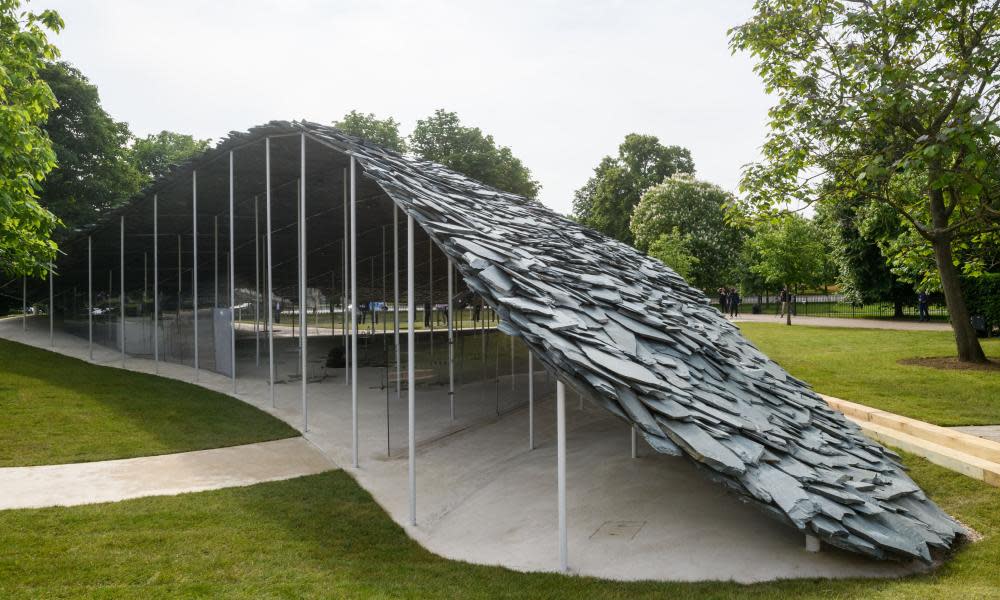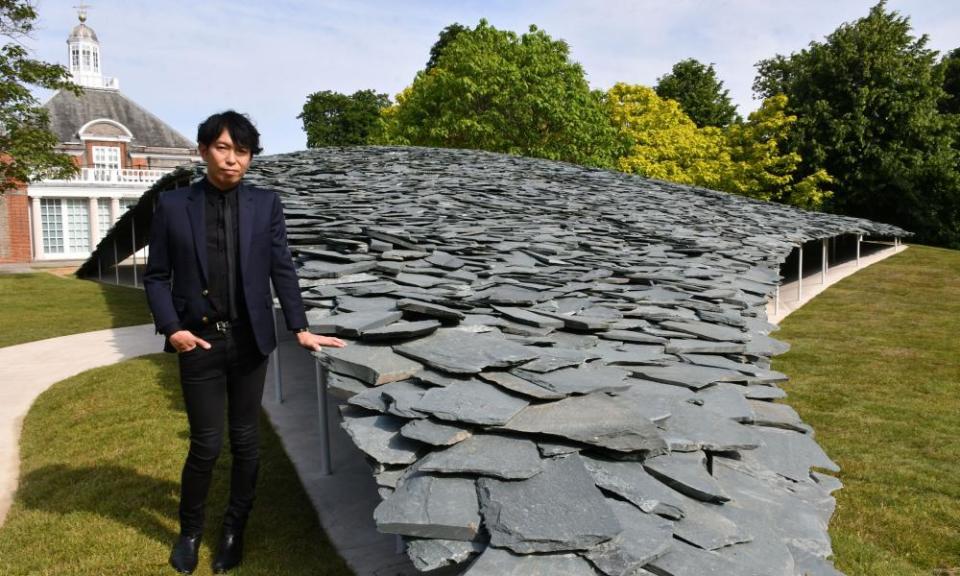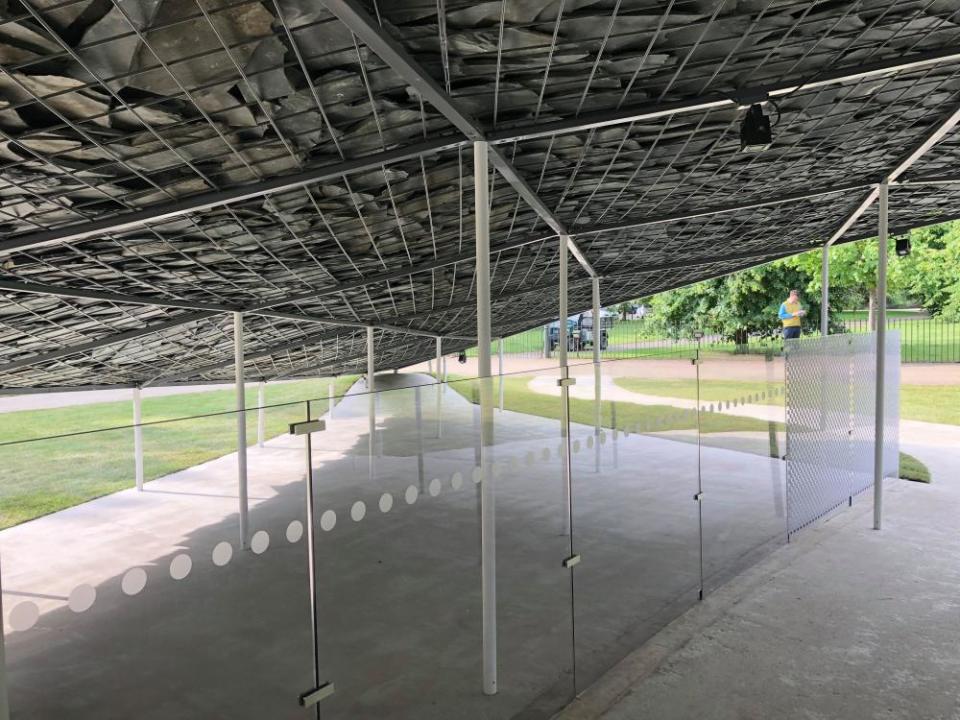Serpentine Pavilion 2019: Japan's great conjuror falls foul of health and safety

Squatting on the lawn like a moody crow, this year’s Serpentine Pavilion is an enigmatic arrival to Kensington Gardens. Formed from hundreds of pieces of rough Cumbrian slate piled up in a gentle mound, it has the look of a bird hunkered down in a hollow in the landscape, making a protective shelter with its outstretched wings. As you approach, you find the great feathered hill is in fact a thin shell, 62 tonnes of slate effortlessly held up on a forest of slender white columns, creating a cave-like space within.
Part bird, part spoil heap, the 19th annual pavilion is the work of Japanese architect Junya Ishigami, 45, who has built an international reputation as an architectural conjuror, concocting daring structures that push the boundaries of what’s technically possible. He made a five-storey metal balloon float in a gallery in Tokyo, and constructed a frame in the Barbican so thin it was practically invisible. He is currently building his most audacious structure yet: a student centre in Japan with a 100-metre-long roof made from a continuous plate of 12mm-thick steel, with not a column in sight. So what drove his slate hillock for the Serpentine?
“I wanted to create a pavilion that felt primitive and ancient,” says Ishigami, “something between building and landscape. Slate roofs are found all over the world, so anyone coming here will be able to identify with it as a basic, archetypal form.”

He refers to the Japanese garden idea of “shakkei”, or borrowed scenery, where the background landscape is incorporated into the design of the garden. Just as a distant mountain might provide a backdrop to a garden of carefully raked gravel, so too does the slate roof of the 1930s Serpentine Gallery (originally built as a tea pavilion) poke up behind Ishigami’s swelling sea of slate.
It is strangely fitting and of its place. Of all architects to have been selected for the annual commission, Ishigami’s approach is perhaps most aligned with the 18th century landscape architects who first laid out Kensington Gardens in the picturesque tradition, with avenues framing views of water and strategically placed follies. He always talks about his work as “making scenery”, his structures creating artificial landscapes that operate in a world all of their own. Which means they can struggle when they come up against practical realities – particularly in the form of the Serpentine’s fiendishly tight timeframe.
“It was really, really difficult this year,” says Tim Leigh, marketing director of Stage One, the York-based fabricators who have built the pavilion every year for the last decade. “Ishigami is the most conceptual architect we have ever worked with. It was a very strained process.”
The final result feels rather lost in translation, the compromised product of a sharp clash of cultures. There are more columns than originally envisaged, and a series of clumsy polycarbonate walls have been installed, following wind analysis by engineers Aecom, to prevent the furniture from blowing away. Ishigami doesn’t hide his disappointment with the walls, which effectively destroy the design, turning the free-flowing space beneath the canopy into a more restricted enclosure.

It was conceived to be accessible from any direction – with children able to scamper beneath the roof where it swoops down at the lower points – but Ishigami says that British health and safety regulations put paid to that idea. The fabricators, on the other hand, pointed to the architect’s focus on aesthetics. More time, both agree, would have helped matters.
It is a familiar story from years past, particularly when Japanese architects have been involved. Ishigami’s former employer, Sanaa, struggled to realise their seamless reflective canopy in 2009, being forced to include similar paraphernalia of walls, fatter columns and bulkier fixings, while Sou Fujimoto’s beguiling space-frame in 2013 was hampered by an excess of balustrades and hand rails. In every case, the architects wished they had more time to resolve such details, which makes you wonder why the gallery hasn’t started appointing them earlier, or making the project biennial, following the lead of the new Dulwich pavilion across the river.
Ishigami’s structure is a striking object, but it could have been so much better, and it is a frustrating outcome in what has been a troubled year for the Serpentine. The institution was criticised for accepting funding from the Sackler family (in light of their alleged role in America’s opioid crisis), and berated over the fact that Ishigami’s practice employed unpaid interns (he insists they were university students on a placement). This week, on the scheduled morning of the pavilion preview on Tuesday, it was announced that the gallery’s CEO, Yana Peel, has resigned, following the Guardian’s disclosure that she co-owns an Israeli cyberweapons company whose software has allegedly been used by authoritarian regimes to spy on dissidents. Peel said she did not want the Serpentine’s work undermined by “misguided and personal attacks on me and my family”.
Whoever takes Peel’s place would be wise to slow down and rethink exactly what the pavilion programme is for. After almost 20 years of commissioning novelty structures to host summer parties for sponsors, it feels like the format could do with a rethink and look beyond the bounds of the gallery’s garden, and the collectors’ estates where the structures end up. There are schools in need of classrooms, public spaces in need of shelters, and countless other clients crying out for the energy and ingenuity that goes into this diverting annual folly.

 Yahoo News
Yahoo News 
